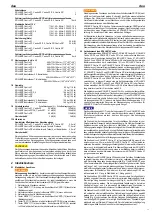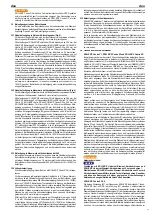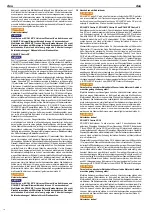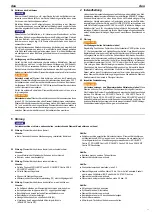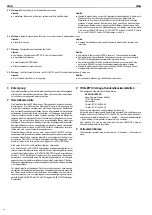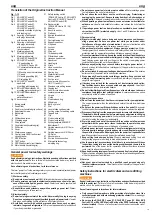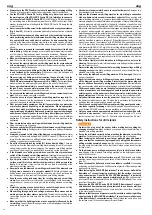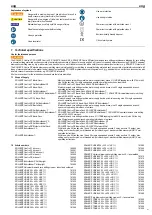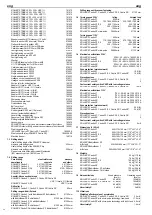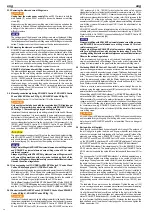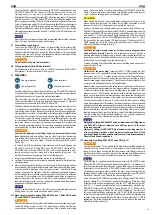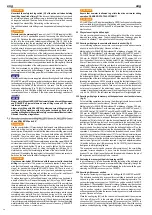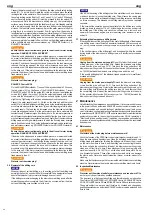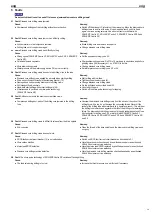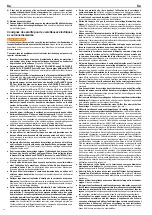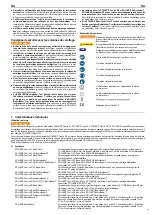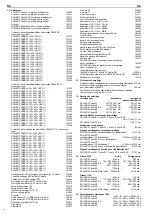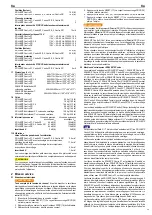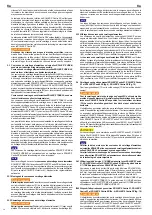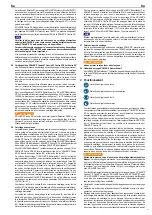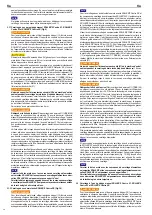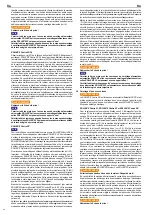
25
To achieve better stability when drilling with ROLLER’S Bohrständer T and
ROLLER’S Centro SR, the spacer set (38) can be mounted. For this, the
clamping angle (10) may have to be disassembled from the ROLLER’S
Bohrständer T by loosening the screws (52). Then clamping angle (10) is pushed
onto the drill collar (13) of the ROLLER’S Centro SR so that the tapped holes
(60) of the gearbox casing of Centro SR are positioned in relation to the screw
holes of the clamping angle (10). Insert the spacer (without fi llister head screws)
and align. Screw in the fi llister head screws included in the set and tighten.
Tighten the fi llister head screws (8) of the clamping angle (10). Fix the mounted
clamping bracket together with Centro SR to the ROLLER’S Bohrständer T as
described in 3.4.
NOTICE
NOTICE
Remove dirt from between rack and slide immediately otherwise the slide can
block. The rack and slide could also be damaged.
2.7 Laser drilling centre pointer
To position the ROLLER’S drill stand, the laser drilling centre pointer ((58)
accessory art. no. 183604) is inserted into the clamping bracket (10) and
tightened with the fi llister head screws (8). After switching on the laser drilling
centre pointer, the drill stand can be aligned accurately at the marked drilling
centre with the laser point and fi xed in position.
WARNING
WARNING
Do not look directly into the laser beam!
2.8 Drilling template ROLLER’S Bohrständer T
A drilling template ((64) accessory art. no. 183605) can be used for ROLLER’S
Bohrständer T for easier location of the plug hole.
3 Operation
Use eye protection
Use a respirator
Use ear protection
Use hand protection
Suitable safety vacuum cleaners/dust extractors, e.g. ROLLER’S Protector M,
a respirator and disposable overalls must be used for work which could produce
health hazardous dusts. Observe the national regulations.
Plug the mains plug into the socket. Check the function of the PRCD fault
current circuit breaker (19) every time before starting drilling (see 2.1 Electrical
connection); not necessary for ROLLER’S Centro DP.
Different material characteristics (concrete, steel-reinforced concrete, porous
or solid masonry) require different and varying feed pressures on the diamond
core drilling crown. Further infl uence is brought to bear by the varying periph-
eral speed and size of the bit. It is inevitable, espe cially during manually controlled
boring, that the machine will occasionally become slightly tilted as it operates.
These factors, which are merely examples of those that might arise, can lead
to overloading of the drive unit during drilling operations. You will normally hear
the turning speed of the motor drop, although the diamond core drilling crown
may become completely blocked. This can lead, especially during manually-
con trolled boring, to torque-related jarring – which will affect the operation.
WARNING
WARNING
Note that the diamond core drilling crown can become blocked at any
time. During hand-held core drilling, there is a risk of injury from the diamond
core drilling machine being torn out of your hand and spinning round as the
torque increases. Never use stage 1 for hand-held drilling with ROLLER’S
Centro SR.
In order to simplify the handling of the machine, and to avoid damage, the
ROLLER’S Centro S1, ROLLER’S Centro S3, ROLLER’S Centro S2/3.5,
ROLLER’S Centro SR and ROLLER’S Centro DP are equipped with a multi-
function electronic system, along with a mechanical sliding clutch. The
multi- function electronic system performs the following tasks:
● Initial-current limitation and jerk-free startup for smooth tapping.
● Limiting of idling speed in order to reduce noise and prevent wear to the motor
and transmission.
● Motor overload regulation relative to feed pressure. Before the drive unit can
be overloaded by excessive feed pressure on the diamond core drilling crown,
or as the result of a blockage, the motor supply current – and thus its turning
speed – is reduced to a minimum. The drive unit does not shut down however.
As the feed pressure is reduced, the turning speed of the drive unit is increased
once more. This procedure, even if it is repeated several times in succession,
prevents damage to the drive unit. If the motor remains stopped despite the
reduction in feed pres sure, the drive unit must be shut down and the diamond-
tipped annular bit freed manually (see 5.).
NOTICE
NOTICE
DO NOT switch the drive unit on and off to loosen a jammed diamond core
drilling crown. This can cause a machine defect (see 5.1.).
3.1.1 Manually-controlled dry boring ROLLER’S Centro S1, ROLLER’S Centro
S3 and ROLLER’S Centro SR (fi g. 4)
WARNING
WARNING
Use the counterholder (12) provided with the diamond core drilling machine for
hand-held drilling. Losing control of the diamond core drilling machine can
cause injuries. Always be prepared for blocking of the diamond core drilling
crown. Never use stage 1 for hand-held drilling with ROLLER’S Centro SR.
There is a risk of injury from the diamond core drilling machine being torn out
of your hand and spinning round as the torque increases.
CAUTION
CAUTION
When drilling dry by hand, the mounted water supply system (15) gets in the
way and should be removed. The holder for the water connection must be
sealed with the lid (14) otherwise dust can get into the machine.
Use dust extraction and suitable safety vacuum cleaner/dust extractor, e.g.
ROLLER’S Protector M. Screw the selected ROLLER’S universal diamond core
drilling crown/ROLLER’S universal diamond core drilling crown LS onto the
drive spindle (11) of the drive unit and lightly hand-tighten. There is no need to
tighten it with a wrench. Use the G ½ UDKB tapping tool (49) (see 2.4.1.). Hold
the drive unit by the motor handle (20) and the brace (12) and place the G ½
UDKB tapping tool (49) in the centre of the desired core hole.
Switch on the
drive unit with safety inching switch (21).
WARNING
WARNING
Never lock the safety inching switch (21) of the drive unit during hand-held
drilling (Risk of injury)! If the drive unit is knocked out of your hand by a
drilling (Risk of injury)!
drilling (Risk of injury)!
blocking diamond core drilling crown, a locked safety inching switch can no
longer be unlocked. The drive unit will then run out of control, and the unit must
be shut down by unplugging it from the mains supply.
To make a tapping hole, drill until the diamond core drilling crown has bored to
a depth of about 5 mm.
WARNING
WARNING
Protector out the mains plug! Screw out the G ½ UDKB tapping tool (49);
loosen with a size 19 open-ended wrench if necessary. Using the dust-extrac-
tion system (see 2.4.2.). Continue boring until the core-drilling opera tion is
complete. Always hold the drive unit by the insulated grip surfaces to safely
absorb torque surges (risk of accident!). Check to ensure correct stability. Carry
out larger core-drilling operations with the drill upright.
Make sure that the suction hose of the safety vacuum cleaner/dust extractor does
not kink and impair the dust extraction. Also make sure that no fragments of stone
or other objects jam in the diamond core drilling crown, the suction rotor ((46)
accessory art. no. 180160) and/or the suction hose. Empty the dust bag of the
safety vacuum cleaner/dust extractor early and clean/renew the fi lter regularly.
Observe the operating instructions of the safety vacuum cleaner/dust extractor.
If the dust produced by dry boring is not removed, the diamond core drilling
crown may overheat and suffer damage. There is also a danger of the compressed
drilling dust in the drilling gap causing the diamond core drilling crown to become
blocked. If you need to work without the dust-extraction system when handling
fi ne-pored materials, Protector the diamond core drilling crown out at regular
intervals and push it back in with a slight turn, so that the drilling dust is expelled
from the drilling gap. Suitable safety equipment, e.g. respirator, disposable
overalls, must be used. Observe the national regulations.
NOTICE
NOTICE
Always wet drilling with ROLLER’S universal diamond core drilling crowns
and ROLLER’S universal diamond core drilling crowns LS for steel-
reinforced concrete!
Always dry drilling with ROLLER’S dry diamond core drilling crowns LS
with core drilling machines with micro-pulse technology. Suck off the
resulting drilling dust with a suitable safety vacuum cleaner/dust extractor!
Observe the national regulations.
3.1.2 Hand-held dry drilling ROLLER’S Centro DP (Fig. 10)
WARNING
WARNING
Use the counterholder (12) provided with the diamond core drilling machine for
hand-held drilling. Losing control of the diamond core drilling machine can
cause injuries. Always bear in mind that the diamond core drilling crown could
block at any time. There is a risk of injury from the diamond core drilling machine
being torn out of your hand and spinning round as the torque increases.
NOTICE
NOTICE
For dry drilling in concrete/steel-reinforced concrete with ROLLER’S Centro
DP and the ROLLER’S dry diamond core drilling crowns LS, it is necessary to
switch on the micro-pulse technology and use a suitable safety vacuum cleaner/
dust extractor of dust class M, e.g. ROLLER’S Protector M, for dust extraction.
For drilling in masonry and other materials, the micro-pulse technology can be
switched off and a suitable safety vacuum cleaner/dust extractor, e.g. ROLLER’S
Protector M, must be used. Observe the national regulations.
Screw the selected ROLLER’S dry diamond core drilling crown TDKB LS onto
the drive spindle (11) of the drive unit and lightly hand-tighten. There is no need
to tighten it with an open-ended wrench. Use the G ½ TDKB tapping tool (49)
(see 2.4.1.). Connect a suitable safety vacuum cleaner/dust extractor, e.g.
ROLLER’S Protector M, to ROLLER’S Centro DP (see 2.4.2.). Switch off the
micro-pulse technology of ROLLER’S Centro DP for tapping. To do this, turn
the micro-pulse technology adjusting ring (Fig. 10 (69)) to the detent position
so that the red markings are not in line. Hold the drive unit by the insulated grip
surfaces of the motor handle (20) and the brace (12) and place the G ½ TDKB
tapping tool (49) in the centre of the desired core hole. Switch on the drive unit
with safety inching switch (21).
eng eng

